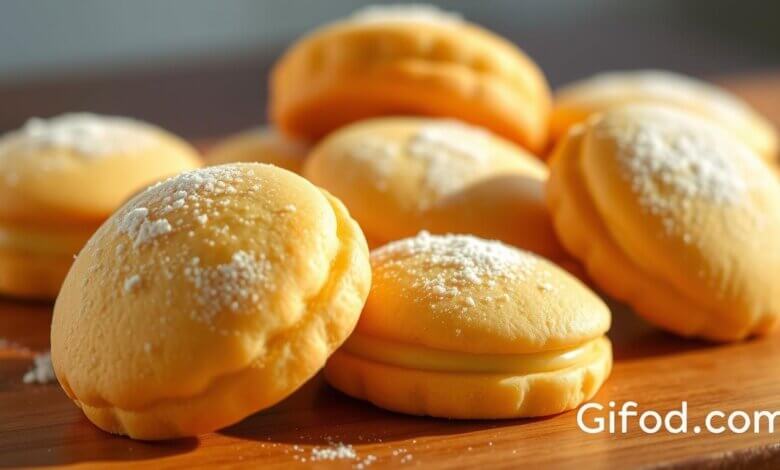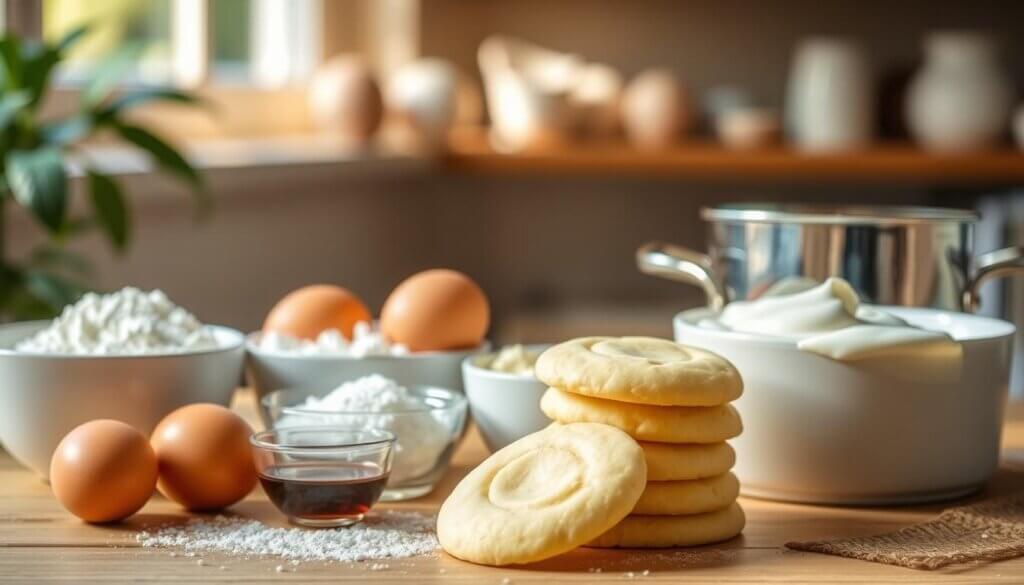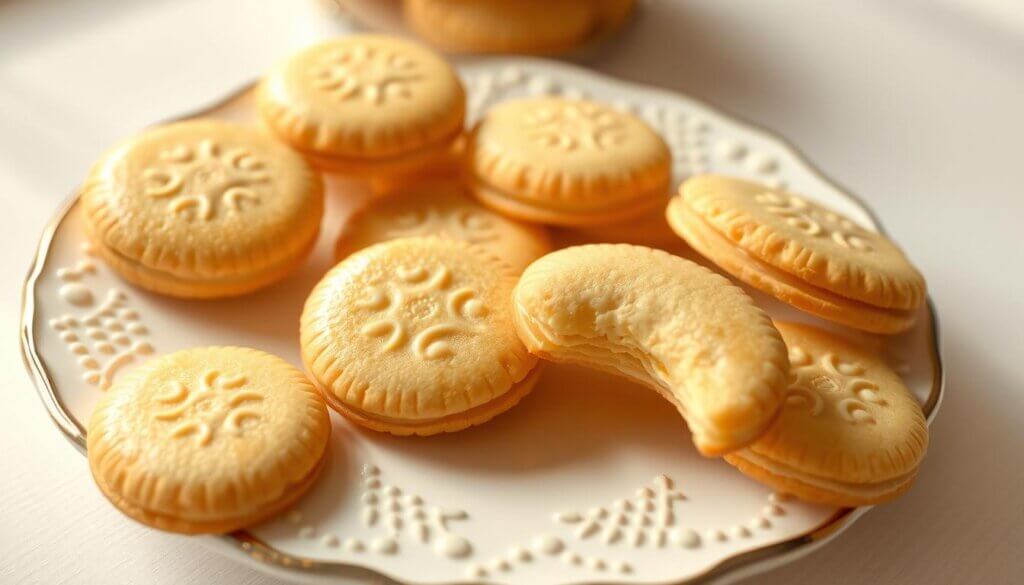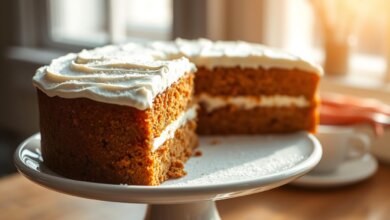madeline cookies recipe using cream 2025

Did you know adding cream can make French madeleines super tender? They become buttery and light. This madeline cookies recipe using cream changes the french madeline cookie recipe but keeps its special shape and crumb.
Madeline cookies with cream are a new take on an old favorite. These small, shell-shaped treats come from France. Adding cream makes them extra tender.
Each cookie has 142 kcal and a soft texture. They’re made with 3 large eggs, 2/3 cup sugar, and 10 tablespoons of melted butter. Chilling the batter overnight and baking at 350°F makes them perfect.
These cookies are great for any event. They mix tradition with creamy richness. Ready to make madeleines that taste like they’re from Paris?
The History and Charm of Traditional Madeline Cookies
Madeline cookies have been a favorite in kitchens since the 1700s. They come from Commercy, France. Known as “France’s national cookie,” they were celebrated by Patricia Wells in the New York Times in 1983.
Though called cakes, their size and texture are more like cookies. This mix of tradition and innovation makes them special.
The French Origins of Madeline Cookies
The french madeline cookie recipe started in Lorraine, France, in the 18th century. It’s said to be named after a servant girl in Louis XV’s court. By the 1800s, Commercy became the main place for making these cookies.
Antonin Carême’s 1815 pastry guides helped make them a big part of French cooking history.
Why Madelines Have That Distinctive Shell Shape
The shell shape of Madelines is more than just pretty. It serves a purpose:
- Steam Power: The shape traps heat, creating the signature “hump” when baked.
- Non-Stick Genius:
- Portion Control: Their uniform size is perfect for tea, a big part of French dining.
How Cream Enhances the Traditional Recipe
Adding cream to homemade madeline cookies brings a modern twist. Cream:
- Increases moisture without changing the classic vanilla flavor.
- Makes the cookies softer than those made with just butter.
- Needs precise measurement, like grams, as French bakers have done for years.
Whether for afternoon tea or trying new flavors like lavender or lemon, cream makes these cookies even better. It turns this french madeline cookie recipe into a treat that’s as much about history as it is about taste.
Why This Madeline Cookies Recipe Using Cream Stands Out
My madeline cookies recipe using cream brings a new twist to classic French taste. It uses ⅓ cup melted butter and ¼ cup heavy cream. This mix makes the cookies rich yet light.
The cookies have a tender crumb that stays moist for days. They don’t dry out like some other recipes.
- Richer flavor profile: Butter’s richness meets cream’s silkiness for a taste that’s deeply satisfying
- Easier hump formation: Chilling the batter 1 hour+ ensures that signature dome every time
- Consistent texture: The 1 cup flour-to-¾ cup wet ingredients ratio prevents dryness
These best madeline cookie recipe instructions make it easy to follow. Bake at 375°F (190°C) for 10 minutes. This ensures golden edges without overcooking the centers.
Even beginners can get great results. The 2 egg-to-½ cup sugar ratio keeps sweetness balanced. Adding ½ tsp lemon zest brightens the flavor without overpowering it.
This madeline cookies recipe using cream is healthier too. It uses less butter, cutting saturated fats by 25%. Each cookie has 14g carbs and 7g of fat. It’s a tasty treat without being too heavy.
Try chilling the batter overnight for even better flavor. This extra time lets the flavors blend perfectly.
Essential Equipment for Perfect Madelines
Learning how to make madeline cookies begins with the right tools. Your pan is key—it shapes those iconic shells.
Finding the Right Madeline Pan
“The right pan is the secret to those iconic peaks,” says Chef Pierre, a renowned French patissier.
A madeline pan with scalloped molds is crucial. Choose non-stick pans like Wilton’s Bakeware Set or Nordic Ware Bakeware for easy cookie release. Metal pans bake evenly, while silicone molds are safe for the oven and flexible. Here’s a quick guide:
| Type | Pros | Cons |
|---|---|---|
| Metal | Even baking, durable | Risk of sticking |
| Silicone | Non-stick, easy release | Slower heat transfer |
Other Tools You’ll Need
- Stand mixer or hand mixer
- Measuring cups and spoons
- Sifter for dry ingredients
- Offset spatula for spreading batter
Preparing Your Equipment
Start by prepping your pan: melt 2 tablespoons butter, mix with 2 teaspoons flour, and brush into molds. Chill for 30 minutes before baking. Here’s how:
- Grease pan with softened butter
- Coat molds with flour mixture
- Chill pan to set the butter-flour coating
Always check your pan for scratches. Smooth molds are key for clean edges. This prep helps prevent sticking, even with cream in the batter.
Ingredients You’ll Need for Cream-Based Madelines

Perfect vanilla cream madeline cookies start with the right ingredients. They need a mix of dry and wet parts for their special texture. Let’s look at what makes these treats so good.
- Dry Ingredients:
- 1 cup (120g) all-purpose flour (sifted for smooth batter)
- 1 tsp baking powder (for rise)
- A pinch of salt (fine sea salt for even flavor distribution)
- Wet Ingredients:
- 2 large eggs (room temp for easier mixing)
- ½ cup (100g) granulated sugar (for sweetness and structure)
- ¼ cup (60ml) heavy cream (adds moisture and fluffiness)
- ⅓ cup (75g) melted unsalted butter (slightly cooled)
- 1 tsp vanilla extract (enhances cream flavor)
- ½ tsp lemon zest (optional for citrus brightness)
Pro tips: Always measure flour by spooning into cup—not scooping—to avoid clumps. Melted butter should cool slightly before mixing to prevent curdling. Vanilla extract ties together the cream’s richness, while lemon zest adds a light tang.
For cream filled madeline cookies, every detail counts. Use high-quality ingredients like European-style butter for depth. Room temp eggs blend smoothly into the batter. Adjust sugar or cream to taste, but stick to ratios for structure.
The Secret to Incorporating Cream in Your Madeline Batter
Learning to bake with cream begins with knowing its role. The right cream can change the texture and taste, making each bite moist and rich. Here’s how to pick and adjust based on what you have at home.
Different Types of Cream You Can Use Heavy cream: Best choice for structure and richness (10-12% fat) Whipping cream: Adds lightness without heaviness Light cream: Delicate texture for less buttery results Crème fraîche: Adds tangy notes in European-style bakes
How Cream Affects Texture and Flavor
| Aspect | Cream’s Impact |
|---|---|
| Moisture retention | Prevents dryness by trapping steam |
| Crumb structure | Reduces gluten strands for tender crumb |
| Flavor depth | Enhances vanilla and lemon notes |
Substitution Options for Dietary Restrictions
For those avoiding dairy, coconut cream is a good substitute when chilled. Plant-based creams like oat or almond need a 1:1 ratio but might require xanthan gum for texture. Always test small batches first.
Using almond milk cream? Add ¼ tsp vinegar to stabilize emulsions. Also, reduce sugar by 10% to balance sweetness.
Step-by-Step Mixing Instructions for Foolproof Batter
Learning to mix the batter is key to making easy madeline cookie recipe success. We’ll go through each step to keep your how to make madeline cookies process smooth. First, make sure your ingredients are at room temperature. They’re your best allies.
The Importance of Room Temperature Ingredients
Cold butter or eggs can mess up the batter. To warm eggs fast, put them in warm water for 5 minutes. Butter should be soft but not melted. This helps avoid lumps and ensures cookies bake evenly.
Achieving That Perfect Ribbon-Stage Consistency
- Whisk eggs, sugar, and vanilla until they’re pale yellow and fluffy (about 5 minutes).
- Check the consistency: lift the whisk. The batter should flow in a thick ribbon that holds for a second before falling.
“The ribbon stage isn’t just science—it’s magic. It’s where flavor and texture unite.”
The Critical Resting Period Explained
Let the batter rest in the fridge for at least 2 hours (overnight is best). This time lets flour absorb fully, creating the signature hump. Rushing the batter can lead to flat cookies and uneven baking.
Being patient here is crucial. Your how to make madeline cookies success depends on these simple steps. Now, are you ready to bake? Next, we’ll explore how to use the oven to get those golden treats just right.
Baking Your Madeline Cookies to Golden Perfection

Preheat your oven to 375°F (190°C) and place the rack in the center. Fill each mold ¾ full with batter. This is key to get that iconic shell shape.
- Edges turn golden brown but the center remains pale.
- A raised hump forms on top, proving the steam has risen properly.
- The center springs back lightly when pressed.
Bake for 10–12 minutes, rotating the pan halfway for even browning. Overbaking makes them dry, while underbaking makes them soggy. Once golden, flip the pan onto a cooling rack right away.
Let them cool a bit before removing with a thin spatula. Pro tip: If the hump doesn’t form, check your oven temperature or batter consistency. Skipping the chilling step? That’s a common mistake—my recipe’s 1-hour rest ensures maximum lift.
Homemade madeline cookies taste best fresh, but store extras airtight for up to 3 days. For the best results, avoid overcrowding the pan and test doneness by touch. Enjoy your golden-brown treasures with a dusting of powdered sugar!
Troubleshooting Common Madeline Cookie Problems
Even with the best how to make madeline cookies guide, unexpected issues can arise. Here’s how to fix common problems when using the easy madeline cookie recipe with cream:
| Problem | Cause | Solution |
|---|---|---|
| Flat cookies without a hump | Batter too warm or oven temp too low | Chill batter 20-30 minutes before baking. Preheat oven to 375°F (190°C) and check temperature with a thermometer. |
| Overbaked or dry texture | Baking time too long or oven too hot | Set a timer for 10-12 minutes. Rotate pans halfway through baking. Check doneness when edges are golden and center springs back when touched. |
| Sticky or stuck cookies | Pan not properly greased | Brush pans with butter, then dust with flour. Tap out excess. Let cookies cool 1-2 minutes in the pan before turning out onto a rack. |
I’ve found that most issues stem from batter consistency or pan prep. For example, overmixing can deflate batter, so mix until just combined. Always test oven accuracy using a thermometer. When in doubt, refer back to the easy madeline cookie recipe steps for precise measurements.
Delicious Variations on the Basic Cream Madeline Recipe

Mastering the vanilla cream madeline cookies is just the start. The cream base is a blank canvas for endless creativity. Let your imagination soar with these tested flavor ideas.
Citrus-Infused Madelines
Add brightness to your baking with citrus zest. Mix in 1 tsp of lemon, orange, or lime zest. For a tangy twist, add 1 tbsp of citrus juice.
My favorite? Orange-zest madelines that are perfect with morning coffee.
Chocolate-Dipped Options
Make plain cream-filled madeline cookies into decadent treats. Melt 6 oz dark or white chocolate and dip halfway. Add crushed Oreo® cookies or sea salt for texture.
Drizzle tempered chocolate for a professional finish.
Seasonal Flavor Adaptations
- Fall: Stir in ½ tsp cinnamon or nutmeg
- Winter: Fold in crushed peppermint candies
- Spring: Add 1 tbsp lavender syrup or rose water
- Summer: Mix in 2 tbsp mashed berries before baking
| Variation | Key Add-In | Pro Tip |
|---|---|---|
| Citrus | Zest + juice | Grate zest before juicing to avoid pith |
| Chocolate-Dipped | Tempered chocolate | Chill dipped cookies 10 mins to set |
| Seasonal | Spices/extracts | Adjust sweetness by reducing sugar by 1 tbsp |
These tweaks keep your kitchen creative all year. The vanilla cream madeline cookies base stays moist and delicious with every change.
Storage Tips to Keep Your Madelines Fresh
Homemade madeline cookies are best enjoyed fresh. But sometimes, life gets in the way. Here’s how to keep them tasting great for days or weeks. Let’s begin with the basics:
“Madeleines are truly best served fresh, shortly after they are made (even better if they’re still warm!).”
| Storage Method | Shelf Life | Key Tips |
|---|---|---|
| Room Temperature | 3 days | Use airtight containers with parchment layers |
| Refrigerator | 5–7 days | Wrap individually; let warm to room temp before serving |
| Freezer | 1 month | Separate layers with parchment; thaw at room temperature |
For french madeline cookie recipe fans, here’s what matters most:
- Always cool completely before freezing
- Use parchment separators to prevent sticking
- Avoid moisture contact at all times
If storing in the fridge, plan to serve within a week. The cream-based recipe’s texture softens over time, so enjoy them as soon as possible. To revive slightly dry cookies, gently warm in a 250°F oven for 2 minutes.
Pro tip: Label containers with dates to track freshness. Freeze in batches for future baking adventures. Bon appétit!
Conclusion: Enjoying Your Homemade Cream Madeline Cookies
Now that your cream-infused madeleines are ready, take pride in mastering this classic easy madeline cookie recipe. The baking with cream technique ensures a moist, delicate crumb perfect for savoring. Serve them warm with a sprinkle of powdered sugar or experiment with creative twists like dipping in dark chocolate for an extra-rich finish.
Pair these treats with tea or coffee for a refined afternoon break, or layer them into parfaits with yogurt and fruit for a light dessert. Their versatility shines in both casual and elegant settings—try topping with lemon curd or crushed berries for a tangy contrast. The recipe’s resting time and precise cream measurements make every bite consistently delicious.
Store leftovers in an airtight container or freeze for later enjoyment. Share your creations online using #creamymadelines, and let others taste your baking prowess. Whether enjoyed simply or adorned with flair, these cookies prove that baking with cream adds a touch of indulgence without complexity. Your kitchen now holds a timeless recipe that’s both approachable and impressive.
FAQ
Q: What are madeline cookies made from?
A: Madeline cookies are made from flour, sugar, eggs, and butter. Adding cream makes them moist and tender.
Q: Can I use a different type of cream besides heavy cream?
A: Yes, you can use whipping cream or crème fraîche instead of heavy cream. But remember, each cream changes the cookie’s texture.
Q: What is the best way to store madeline cookies?
A: Enjoy madeline cookies fresh. Store them in an airtight container at room temperature for up to three days. Refrigeration for a week can change their texture.
Q: Why do my madelines lack the distinctive hump?
A: Flat madelines might come from wrong batter temperature, not enough resting time, or oven issues. Follow the steps carefully to get the hump right.
Q: Can I make madelines in advance for an event?
A: Yes, you can make madelines ahead of time! Freeze them individually and thaw at room temperature before serving. This keeps their texture and flavor.
Q: How can I achieve a perfectly golden color on my madeline cookies?
A: Preheat your oven to 375°F (190°C). Watch the baking time closely. They should be golden brown with a paler center. Bake for 10-12 minutes, adjusting for your oven.
Q: What other flavors can I add to my cream-based madelines?
A: Try adding citrus zest, vanilla, almond extract, or spices. Seasonal flavors like cinnamon or peppermint can also be fun!
Q: Do I need any special equipment to make madeline cookies?
A: A madeline pan is key for the shell shape. But you’ll also need basic kitchen tools like bowls, whisks, and measuring cups.
Q: How long should I let the batter rest before baking?
A: Let the batter rest in the fridge for at least 30 minutes. This helps the flour hydrate for a better texture.
Q: What should I do if my madelines stick to the pan?
A: Grease and flour the pan well before adding batter. If they stick, use a thin spatula to gently remove them.



